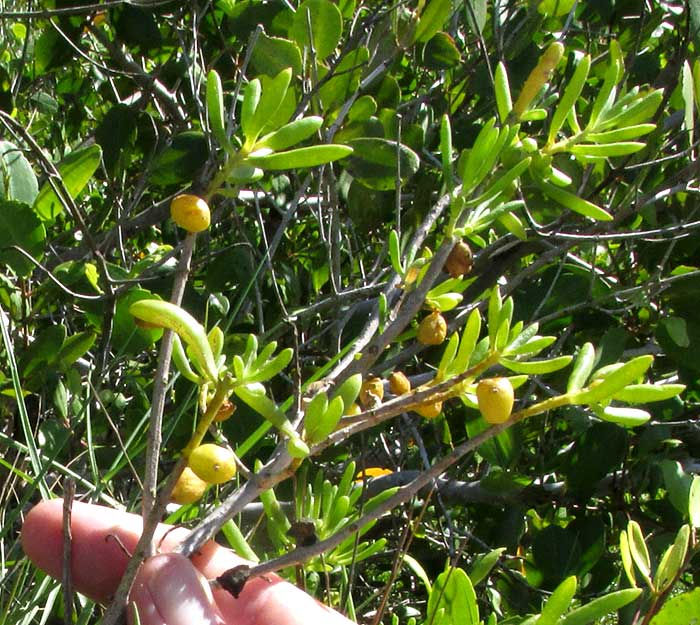Excerpts from Jim Conrad's
Naturalist Newsletter

from the October 26, 2014 Newsletter issued from Río Lagartos, on the Yucatan Peninsula's northern coast (~N21.60°, ~W88.16°), Yucatán state, MÉXICO
SALTWORT
In mud at the very edge of standing, salty water in the mangroves often there's a much branching, woody-stemmed bush about two feet high (60cm) bearing short, slender, succulent leaves -- and nowadays pea-sized, yellowish fruits -- as seen above.
In certain mudflats where water stands at high tide or after rains, this bush forms dense, one-species colonies, and it's very common nearly everyplace where saltwater meets mud. But, what wildflower or bush displays such a combination of succulent leaves and fruits? The succulent leaves could belong to the North's rock-loving stonecrops, genus Sedum, as you can see below:

However, the fruits are unlike anything Northerners are likely to find in woods and fields, like little yellow-green potatoes with "eyes" irregularly scattered across their asymmetrical forms, as shown below:

The fruit's irregular lumpiness can be explained by its technically being considered a "drupaceous syncarps." The word drupaceous means "like a drupe," and a drupe is a fruit such as a peach, with a fleshy covering over a hard seed or pit that doesn't split open at maturity. Syncarps are "multiple fruits" derived from clusters of individual fruits that as they mature and enlarge merge with one another to form a single larger, fruit-like item, such as a pineapple, mulberry or Osage-orange. On our plant's multiple fruits, each thing looking like a potato's eye is the remnant of a calyx and sexual parts of a single flower. Each flower's enlarging fruits have fused so completely that there's little indication that it all started out as a cluster of flower ovaries.
The reason that this combination of having multiple-type fruits on a bush with succulent, stonecrop-like leaves doesn't register in the minds of temperate-zone plant fanciers is that this plant is a member of a plant family, the Bataceae, whose members only show up along the coasts of tropical and subtropical lands. The Bataceae family is so peculiar that it contains only one genus, the genus Batis, and in Batis there are only two species, of which our mangrove-mud-loving shrub is one. It's BATIS MARITIMA, which goes by several English names, including Saltwort, Beachwort, Turtleweed, and Pickleweed. It's distributed coastally from the Carolinas and southern California south to northern South America and throughout the Caribbean area, plus some Pacific islands, including Hawaii, where it's thought to have been introduced.
Saltwort is extraordinarily tolerant of very high salinity and can survive being covered by water for long periods. These adaptations enable it to be very important ecologically when it becomes a major colonizer after mangroves are destroyed by hurricanes. It grows slowly in soils with high salt concentrations but suffers little competition from other plants. It deals with very salty water by "sequestering," or setting salt aside, in its cells' vacuoles, and eventually shedding the leaves when their salt content reaches a certain level.
It's also been found that Saltwort roots are colonized by a certain kind of fungus technically referred to as a "vesicular-arbuscular mycorrhiza." This relationship indirectly reduces water stress on the plant, and improves phosphate nutrition. The term vesicular-arbuscular refers to a kind of mycorrhiza in which the fungal hyphae penetrate the cortical (bark) cells of the roots of a vascular plant.
Not only does Saltwort perform the important job of occupying and thus stabilizing muddy areas that are so salty and waterlogged that other plants can't live there, but also their succulent, salty leaves are nice to nibble on. Sometimes folks sprinkle them in salads, and in some places even cook them as greens in pots, or serve them up pureed or pickled.
In Puerto Rico, traditionally it's been used in folk herbal medicine to treat gout, eczema, psoriasis, rheumatism, blood disorders, and thyroid disorders.
This homely looking little bush living in salty mud is worth knowing and tipping one's hat to.